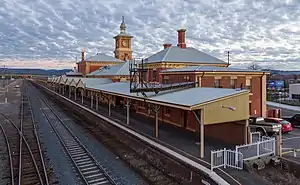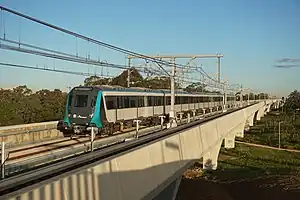Australia might not be as well-known as the United States for being the land of the automobile, but due to the large distances between cities, extensive lobbying from the automobile industry, and the lack of good public transit outside a select few cities, it has made itself one of the most car-centric countries in the world.
Although travelling around rural or regional cities is best done by car, all hope is not lost for travellers seeking to travel car-free while still having an enjoyable experience. In some larger cities, such as Sydney, Melbourne or Perth, a car might prove to be more of a hassle than a necessity.
Understand
Get around
By plane
Australia's vast distances and sparse population mean that for travel between major cities, flying is typically the most convenient and popular option, and often the cheapest.
By intercity rail

- Main article: Rail travel in Australia
By coach
Australia's big eastern cities are served by intercity coach lines. However, no coach lines cross the Nullarbor Plain to Perth. Greyhound Australia and Firefly Express are the main long-distance coach operators. State government-owned operators in New South Wales, Victoria, Queensland and Western Australia provide service from the respective state capitals to the country towns, while that gap is filled by smaller private operators in South Australia.
Destinations
Good cities

- Brisbane (Queensland)
- Gold Coast (Queensland)
- Katoomba–Leura (New South Wales)
- Melbourne (Victoria) — well-known for its extensive tram network, which is the largest surviving one in the world.
- Newcastle (New South Wales) – getting between Newcastle and some of its outer suburbs can suck (unless you don't mind travelling on buses), but there's very little reason why you would do so as a traveller. Most of its points of interests are either along the city's two main rail lines: the Central Coast & Newcastle Line from Lake Macquarie, the Central Coast and Sydney, and the Hunter Line from Maitland, Dungog and Scone (which can be infrequent on weekends, though). However, Newcastle Interchange ends at the western edge of the CBD – anywhere east and you will need to transfer onto the city's single light rail line, connecting most of the CBD (where most POIs are) with the beach and the station. It's nowhere near "good" for global standards, but it is for Australian standards.
- Perth (Western Australia) – airport, CBD, Freo and the north: all these major important destinations are connected via its relatively extensive suburban rail network (which is the third-most used network in the country, after Sydney and Melbourne respectively). Although it is not very radial, this should not significantly pose an issue for travellers. The few areas not part of the rail network are those deep in the suburbs.
- Sydney (New South Wales) — although the city is home to several transit deserts, it is the only city in Australia with a metro network and has the most radial rail network of any city. Complemented with excellent off-peak frequencies on its suburban rail network, it is possible to get around almost the entire city via its trains, light rail, metro and ferries. The one major exception where transit tends to be poor is near beaches; in fact, out of Sydney's many beaches, only Cronulla is connected by train, and Manly by ferry. All other beaches, including Bondi Beach and Coogee, are only accessible via bus (though they are even harder to reach by car). Similarly, all of the Northern Beaches (and other NIMBY-heavy suburbs) lack rail access or BRT – but driving isn't any better. In the suburbs south of Sydney, many beaches can be reached by bus.
Manageable cities

- Adelaide (South Australia) — while not as good as the Big Four, Adelaide has a serviceable public transportation network comprising of buses, trains and a single tram line. Be sure to check the schedules and plan accordingly, as frequencies are not particularly high. Frequencies drop sharply on weekends and after evening rush hour on weekdays, with 1-2 buses or trains per hour being typical, and some lines do not operate at all on the weekends.
- Bendigo (Victoria)
- Canberra (Australian Capital Territory) – much of its roots were developed in the 1960s during the rise of the automobile, which has resulted in very wide roads, no suburban rail and a car-centric approach to its core districts. However, the city's progressive nature has resulted in the increase of reliable rapid bus links, bike freeways (and is the most bike-friendly city in Australia), and is in the midst of building a grand light rail network (which only consists of a single line as of 2024, though).
- Central Coast (New South Wales)
- Hahndorf (South Australia) — accessible by public bus from Adelaide. Once you're in Hahndorf, the main tourist area is compact enough to be explored on foot.
- Maitland (New South Wales) – Maitland might seem intimidating to visit without a car, especially considering how little of an appealing tourist destination it is for those who aren't from the area. However, intercity suburban rail on the Hunter Line (HUN) are decently frequent from Newcastle, Scone and Dungog, with five stations in Maitland. While the Hunter Line is primarily targeted at getting commuters to Newcastle in the morning and back in the afternoon, you only need to walk a kilometre at max to a major point of interest to a station. Do be warned: the amount of footpaths in Maitland is very low compared to the average NSW city. Ultimately, getting without a car in Maitland might not be great, but it's not as bad as many other Australian or American cities of a similar size.
- Wollongong (New South Wales) – you can reach Wollongong by tolerably frequent intercity suburban rail from Sydney with a north–south line between Helensburgh and Port Kembla with trains every 10–15 minutes during the day – the line branches at Conniston towards Shellharbour and Kiama, but this line is single track and with far lower frequencies. Nonetheless, this is the only railway line on NSW Trainlink's Intercity Network that are less than 1 km from a beach – these are often a much easier alternative to the vast majority of Sydney's beaches which lack rail access. Most of its sights not on the rail corridor are served by buses.
Bad cities
- Albury-Wodonga (New South Wales/Victoria) – the largest border cities between New South Wales and Victoria are also one of the most car-centric (and carbrained) cities in the southeast with over 90 per cent of short trips made by car. While Albury CBD is right next to its railway station, Wodonga CBD might seem an eternity away from its CBD. For places away from the CBD, your primary mode of transit will be buses (which tend to be worse the further away you go from Albury CBD).
- Alice Springs (Northern Territory) – Alice only has a singlular railway station in an industrialised part of the city. Unfortunately, crime in Alice Springs tends to be significantly higher than a typical Australian city, so extra caution needs to be taken when visiting this city without a car. Additionally, there are only eight bus routes in the city and they do not operate on Sundays.
- Cairns (Queensland)
- Darwin (Northern Territory)
- Launceston (Tasmania)
- Hobart (Tasmania) – the Tasmanian capital is the largest city without any passenger rail – plans to build a light rail between the CBD and the northern suburbs have high public support but the lack of political will has left it hanging in the closet. This has left the only form of proper transit being slow, unreliable and infrequent buses (even disguised as a "metro"!), which are mainly centred at getting commuters in the suburbs to the CBD in the morning and back to the suburbs in the afternoon – unfortunately, travellers – not even business travellers – aren't fully catered for. However, for those still determined, it is not impossible – you just need the patience: the SkyBus operates express bus services between HBA Airport and the CBD for $19.50 one way per adult. Since the CBD is small enough to be traversed on foot, most important museums and points of interests are within a walking distance, with two outliers being MONA and Mount Wellington. To get to MONA, an express ferry route operates between the dock and the museum, while buses run to Mount Wellington.
- Sunshine Coast and Noosa (Queensland) – while Queensland's CityRail trains do technically operate in the Sunshine Coast, it only operates on the western fringes of it bypassing almost all population centres. Light rail has been continually turned down by vocal NIMBYs while a suburban rail is still in the making. Until the railway line is built to Maroochydore, your best port of call is to use the infrequent buses.
- Toowoomba (Queensland)
- Townsville (Queensland)
National parks
In the Sydney area, parts of the Blue Mountains, Brisbane Water National Park, Lane Cove National Park and Royal National Park can be visited by train.
Adelaide's Belair National Park can also be reached by train. Cleland National Park in the Adelaide Hills can be reached on Adelaide's bus network.